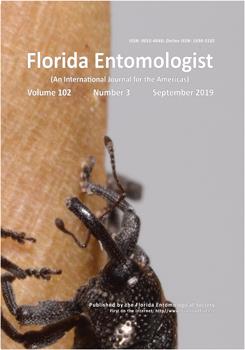Brazil recently began commercial cultivation of macadamia nuts, making it necessary to identify the insect pests attacking them in order to develop a pest management program. This study reports the occurrence of lepidopteran borers in macadamia fruits of orchards from the municipality of Jaboticabal, state of São Paulo, Brazil. Sampling was performed biweekly by visually searching for attacked fruits. The nuts collected had circular holes caused by lepidopteran larvae. The borers identified were Elaphria hypophaea (Hampson) (Noctuidae), Gymnandrosoma aurantianum (Lima) (Tortricidae), and Ectomyelois ceratoniae (Zeller) (Pyralidae), which occurred in the stages of fruit formation and growth, ripe fruits, and dropped fruits, respectively. This is the first record of E. hypophaea as a macadamia fruit borer worldwide, and the first record of G. aurantianum and E. ceratoniae as macadamia fruit borers in Brazil.
The macadamia nut tree, Macadamia integrifolia Maiden and Betche (Proteaceae), is native to Australia. Macadamia nuts have a refined taste and are very popular for consumption raw, roasted, or as an ingredient in chocolates. These nuts have beneficial properties for human health. For example, they have high nutritional quality and fatty-acid content, which can delay aging and protect the cardiovascular system (Pimentel 2007; Freitas & Naves 2010; Piza & Moriya 2014).
The wide dissemination of its nutritional qualities has increased the demand for the macadamia nut and its derivatives. Several countries cultivate macadamia nuts, most prominently Australia, the USA, South Africa, Kenya, Guatemala, Brazil, Malawi, Colombia, and China. Macadamia nut cultivation is currently expanding and attracting attention from the global agricultural trade (Piza & Moriya 2014).
Insect pests affect macadamia nut productivity and may cause significant losses to producers. Australia and the US are the world's largest producers of macadamia nuts, and the lepidopteran borers Cryptophlebia ombrodelta (Lower) (Tortricidae), Dichocrocis punctiferalis (Guenée) (Pyralidae), and Assara seminivalle (Turner) (Pyralidae) have been reported as pests of the macadamia nut tree (Gallagher et al. 2003). In Brazil, there are no records to date of these species attacking the fruits of this plant.
This study reports the occurrence of lepidopteran borers in macadamia nut trees from the municipality of Jaboticabal, state of São Paulo, Brazil. The study was conducted in 2 orchards. One of them was located on the campus of the Paulista State University School of Agrarian and Veterinary Sciences, Jaboticabal Campus, and consisted of trees of cultivars ‘IAC S-10' and ‘IAC 8-17,' approximately 30 yr old. The second orchard was located on the “Fazendinha Belo Horizonte” farm, planted with 18-yr-old trees of cultivars ‘HAES 660' and ‘HAES 344.’ The association of borers with the macadamia nut fruits was determined through sampling the bored fruits (Fig. 1). The material collected had circular holes caused by larvae. Sampling was performed biweekly on 10 randomly chosen plants from each orchard, from Aug 2011 through May 2012, and from Aug 2012 through May 2013.
The collected fruits were sent to the Insect Ecology Laboratory, Paulista State University School of Agrarian and Veterinary Sciences, Jaboticabal Campus, where they were placed in 500 mL transparent plastic cups with 5.0 cm of soil, and sealed with voile to keep the insects from escaping, but allowing fresh air into the container. Soil was used because some lepidopteran species pupate in the soil. The cups were kept in a climate-controlled room with 25°C ± 1 °C temperature, 70% ± 10% relative humidity, and a 12:12 h (L:D) photoperiod. After emergence, lepidopteran adults were collected and sent to Vitor Os-mar Becker (Uiraçu Institute, Bahia State, Brazil) for identification.
Fig. 1.
(A) Macadamia nut trees; (B) bored fruit; and (C) fruit with a hole made by a lepidopteran borer.

The lepidopteran borer species associated with fruits of macadamia nut trees were identified as Elaphria hypophaea (Hampson) (Noctuidae), Gymnandrosoma aurantianum (Lima) (Tortricidae), and Ectomyelois ceratoniae (Zeller) (Pyralidae). The larvae of these species occurred in the stages of fruit formation and growth, ripe fruits, and dropped fruits, respectively (Fig. 2). Gymnandrosoma aurantianum and E. ceratoniae have been reported as important pests of macadamia nut fruits in Australia, Costa Rica, and Israel, directly attacking the fruits and causing significant losses (Wysoki 1986; Blanco-Metzler et al. 2013; Carvalho et al. 2015). In Brazil, G. aurantianum is a pest of Citrus (Rutaceae); the females lay eggs on the orange fruits, and the newly hatched larvae penetrate and feed inside the fruits (Garcia 1998). Gymnandrosoma aurantianum is one of the main pests of macadamia nuts in Costa Rica, and it causes damage to the nuts, and feeds on the kernel (Nakano & Soares 1995; Blanco-Metzler et al. 2013). These authors reported that its life cycle (egg to adult) lasts nearly 36 d, and the species may produce up to 10 generations per yr, depending on weather conditions and food availability.
This is the first record of E. hypophaea as a macadamia fruit borer worldwide. This is also the first report of G. aurantianum and E. ceratoniae as macadamia fruit borers in Brazil. These findings indicate that these lepidopteran pests are potentially damaging to macadamia nuts. Few studies have investigated the occurrence of insects associated with macadamia nuts in Brazil, because commercial production in this country is recent. Therefore, most of the available information on pests and control methods is derived from studies conducted in Australia and the US. This highlights the need for studies on pests and natural enemies associated with macadamia nut trees in producing countries, including Brazil, which ranks sixth largest among the world's macadamia nut exporting countries. Finally, identifying species associated with macadamia trees forms the basis for developing integrated pest management programs (Schneider et al. 2012).
Fig. 2.
(A) Larvae and (B) adult of Gymnandrosoma aurantianum; (C) Ectomyelois ceratoniae; and (D) Elaphria hypophaea.

We thank the National Council for Scientific and Technological Development (CNPq) for the grant awarded to the first, second, and third authors, and the São Paulo Research Foundation (FAPESP) for financial support of this study. We also are grateful to the staff of the Fazendinha Belo Horizonte for assistance during the sampling procedures.





